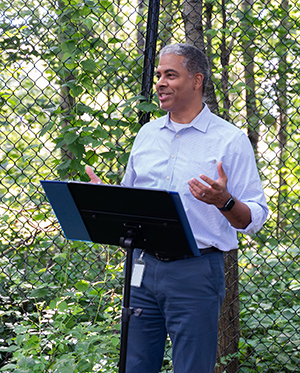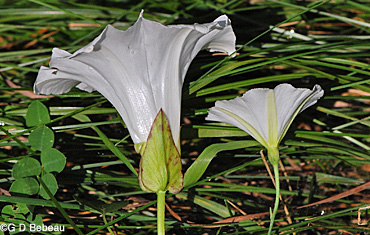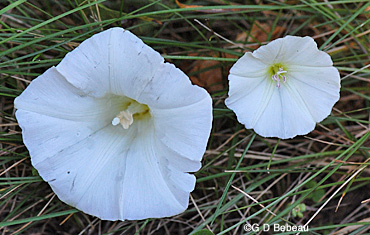Friends of the Wildflower Garden

These short articles are written to highlight the connections of the plants, history and lore of the Eloise Butler Wildflower Garden with different time frames or outside connections. A web of present and past events
July 2025
Eloise Butler's late summer plant review
Now is the time to transfer spring ephemerals
MPRB celebrates The Friends
On Thursday evening July 17 the leadership of the Minneapolis Park and Recreation Board (MPRB) held an event celebrating the work of the Friends of the Wildflower Garden over the past decades.
Superintendent Al Bangoura specifically highlighted two recent efforts - the Friends $95,000 contribution for completing the new fencing on the east side of the Wildflower Garden and the 20 years of effort of the Friends Invasive Plant Action Group (FIPAG), initiated and led by Jim Proctor, in removing invasives and restoring native habitat in Volunteer Stewardship Area surrounding the Garden. Fittingly, the event was held on the southeast hillside next to the new fence and overlooking the hillside where the volunteers of FIPAG have been restoring the oak savanna habitat that once covered that area of the Wirth Park.


Besides Mr. Bangoura, Commissioner Meg Forney, Friends President Jennifer Olson and Jim Proctor spoke, followed by a tour of the restoration area led by Jim Proctor.
Thanks to Superintendent Bangoura, Commissioner Forney, the leadership of the Environmental Stewardship Division of the MPRB and Garden Curator Susan Wilkins, all of whom were present, for putting on this event, and to all the volunteers who enable the success of the Friends.
Below: MPRB Commissioner Meg Forney speaking at the Friends celebration. Superintendent Al Bangoura at right. Photo G D Bebeau.

Eloise Butler's late summer plant review.
One hundred fourteen years after she wrote her 1911 newspaper columns, Eloise Butler's review of late summer plants is still as valid as the day it was written.

From April through September 1911 Eloise wrote a column each week for the Minneapolis Sunday Tribune. She used the column to educate, criticize, advocate for the Wildflower Garden and sometimes to advertise garden tours.
Here is just a sampling of bits from the columns of late summer - albeit sometimes with politically incorrect wording:
On August 6 she write about vegetable tramps, those imported species from other lands the pre-empt our natives - “Some naturalized plant citizens, with attractive flowers, one might like to have in the garden, if they were not so aggressive.” The Joe-Pye weeds and snakeroots also get a review, as does boneset, of which “folks brought up in the old-fashioned way have a bitter memory . . . which in the spring was dealt out copiously to every member of the household, as a thorough remedy to prevent or to remove influenzal bone aches and, in general, ‘to purify the blood.’ ”
On August 13 its the plantains and the one that “farmers put the leaves in their hats to protect from sunstroke in haying time” and then on to the composites and the sensitiveness of the partridge pea.
On August 20 she details the flower "little girls hooked over their ears to become fine ladies with gold ear-drops;" followed by "what is that bush some distance within the swamp with luminous with starry globes?"
In the last column of August on the 27th she states: “The Scotch made no mistake in selecting the thistle for their national flower. Bristling with needle-like prickles, a type of stern independence, it does not admit of close intimacy,” She then tells you which are good and which are bad thistles. You can also find out about dog fennel and the Grass of Parnassus, now rare in this area.
The link goes to our archive page listing links to all the 1911 columns. Each article is rewritten in web format, color illustrated, with a printable copy and a pdf of the original text.
Now is the time to transfer spring ephemerals
The time from now to early August is the window to transplant any spring ephemerals that you wish to move.
The plants are semi-dormant or fully dormant and have set seed. Native plant nurseries have available fresh seed for sowing and in certain species, bare root plants and bulbs such as Wild Hyacinth. If you are thinking about seeding some new species, be aware of the germination characteristics of each species. Seed suppliers typically provide this information. Some species require several cycles of cold, warmth, cold before they will germinate and may not produce a plant until the second season.


Morning glories of the fields
One of the showiest white mid-summer flowers is now in bloom along trails and may be spotted in the Wildflower Garden where it was been for 116 years.

I am writing of the native wild morning glory known as hedge bindweed and sometimes as "old man’s night cap." The scientific name is Calystegia sepium in the Morning Glory plant family. It is termed a “bindweed” as it is a vine which twines counter clockwise around things for support. Bindweeds also have showy flowers and leaves with a triangular outline. The trumpet of this flower can be 3 inches wide with yellow at the base of the throat. Eloise Butler said it spends its time “doing good service by concealing unsightly objects with its lovely large flowers of pale pink or white, and making dense tangles in the woods, which, in the struggle to break through, forcibly impress one to rename it bindweed. Being common and a weed, it is not properly appreciated. It might be improved and varied by cultivation, and it would outrank its relative, the tame morning glory, Ipomaea, as a porch vine, for it is a perennial and can always be depended upon to furnish shade.”

Do not confuse hedge bindweed with a smaller introduced relative in the morning glory family, the field bindweed, Convolvulus arvensis. The flower is smaller, sometimes with a pinkish tinge like its big brother but lacks the large cup-shaped bracts at the base of the flower calyx of the hedge bindweed. Both bloom at the same time of year. Eloise Butler had introduced the smaller species to the Garden in 1931. It has not been present for some years but may be seen around the metro area in disturbed places.
Below: A comparison of Hedge Bindweed (on the left in both photos) and Field Bindweed, (on the right in both photos). Hedge Bindweed is much larger in width and length and Field Bindweed does not have the large cup-like bracts surrounding the calyx.



Neither of these species have distinctly pointed fringes of the tips of the petals which distinguish them from the poisonous Jimsonweed, Datura stramonium, which is not a morning glory but has a similar looking flower and has been found in DNR surveys in Hennepin and Ramsey counties.
Links to information sheets on these plants:
A lack of modern tools

Seventy five years ago in November of 1950 Garden Curator Martha Crone completed a tool inventory of the Garden before closing up shop for the winter.
When looking at the list, consider how strange it is today to not see anything with an electric motor, a battery, or a gas engine. Neither Martha or Eloise before her, had any such labor saving devices. Compare that to what the typical household garage holds today or to the array of equipment the MPRB has available for their staff. When was the last time you used a scythe? Fifty-eight years ago for me!
Historical Photo
A view in the upland part of the Wildflower Garden photographed by Martha Crone on July 16, 1953, nine years after she first began planting the upland. The path is lined with pea gravel and some of the aluminum plant ID stakes provided by Clinton Odell are visible.

*Photo note: Photos without credit are by G D Bebeau and may be used for educational purposes under Creative Commons license CC BY-SA 3.0. Learn about this at https://creativecommons.org/share-your-work/cclicenses/
All selections published in 2025
All selections published in 2024
All selections published in 2023